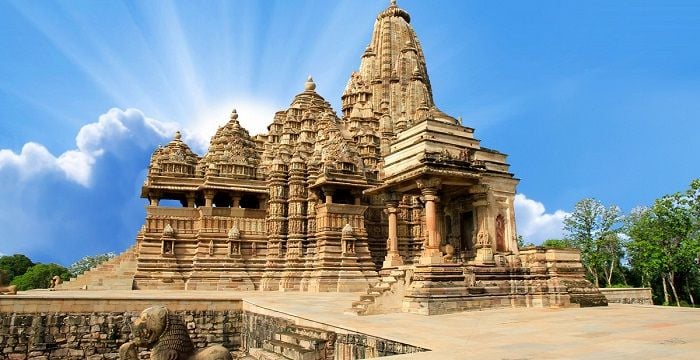Khajuraho Temples: A Jewel in India’s Heritage Crown as a World Heritage Site
Nestled in the heart of Madhya Pradesh, the Khajuraho Group of Monuments stands as an architectural marvel, a testament to India’s artistic and cultural heritage. Recognized as a UNESCO World Heritage Site, these ancient temples have not only survived the sands of time but also mesmerized the world with their intricate sculptures and architectural brilliance.

A Glimpse into History:
The Khajuraho Temples, built between the 9th and 11th centuries during the Chandela dynasty, are renowned for their exquisite architecture and intricate stone carvings. Originally a complex of 85 temples, only around 20 have survived, showcasing a fascinating blend of Hindu, Jain, and other artistic influences.
Date of Designation:
The Khajuraho Group of Monuments earned its esteemed place on the UNESCO World Heritage List on October 15, 1982. This recognition elevated the temples to global prominence, celebrating their architectural ingenuity and historical significance.
Reasons Behind its Designation:
Several factors contributed to the inclusion of the Khajuraho Temples in the UNESCO World Heritage List:
- Architectural Brilliance: The Khajuraho Temples are a prime example of medieval Indian architecture. Intricate carvings adorn the walls, depicting diverse subjects ranging from deities and celestial beings to everyday life and human emotions, showcasing the immense artistic talent of the craftsmen.
- Cultural Significance: The temples reflect the spiritual and cultural diversity of ancient India. They stand as a tribute to the coexistence of multiple religious beliefs and philosophies, exemplifying the harmonious blend of religious tolerance prevalent during that era.
- Erotic Sculptures: While often the focus of attention, the temples’ famous erotic sculptures are only a small fraction of the carvings. These depictions are a celebration of human desires and relationships, adding a touch of realism to the artistic narrative.
- Historical Insights: The sculptures provide insights into the social, cultural, and artistic nuances of the time. They offer a window into the society’s norms, beliefs, and values, contributing to a deeper understanding of India’s historical past.
Impact of World Heritage Status:
The UNESCO World Heritage recognition has left an indelible impact on the Khajuraho Temples and the surrounding region:
- Preservation and Restoration: The designation has prompted enhanced efforts to preserve and restore the temples. Conservation projects have been undertaken to protect the delicate carvings from weathering and degradation.
- Cultural Tourism: The World Heritage status has significantly boosted tourism to Khajuraho, drawing visitors from around the globe to witness the temples’ grandeur and historical significance. This influx of tourists has bolstered local economies and provided livelihood opportunities for the community.
- Educational Significance: The temples now serve as educational resources, fostering awareness about India’s rich cultural heritage, architectural achievements, and the need for their protection.
The Khajuraho Temples’ journey to becoming a UNESCO World Heritage Site is a testament to their timeless beauty, historical significance, and the enduring power of artistic expression. As they continue to stand as guardians of India’s cultural legacy, they remind us of the importance of preserving our heritage for future generations and celebrating the diversity that enriches our world.




